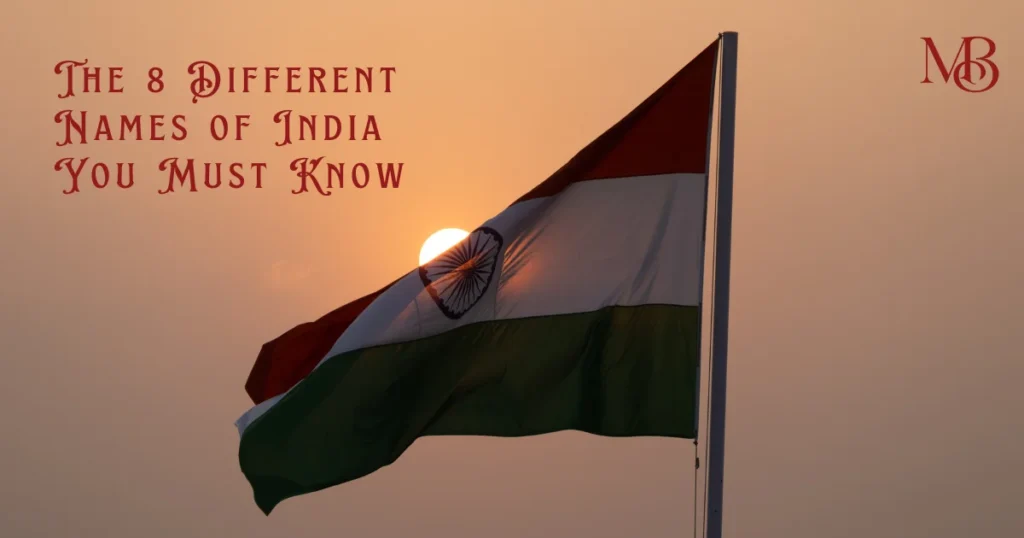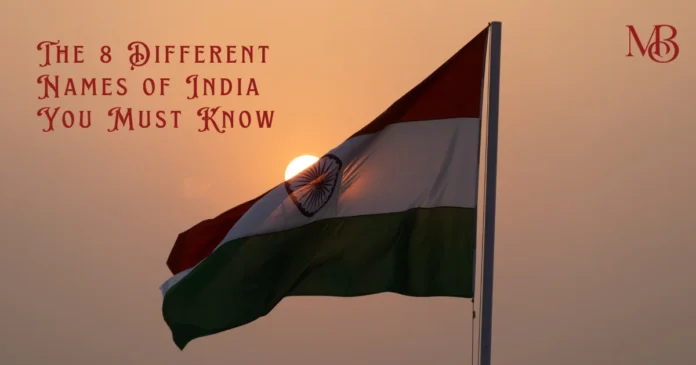Different Names of India: A land known for its incredible diversity, has carried many names throughout its long and storied history. Each name reflects a different cultural lens, shaped by the people who traveled, traded, and settled here. From ancient Vedic texts to global historical records, the variety of names for India highlights the nation’s role as a crossroads of civilizations. Let’s explore the fascinating origins and meanings of different names of India.

1. Bharat: The Ancient Name of Pride
One of the oldest and most enduring names for India is “Bharat.” This name is rooted in the ancient Sanskrit texts, specifically the Mahabharata and the Puranas, where it refers to the land ruled by the legendary King Bharata. He is considered a symbol of strength and unity, representing the vast subcontinent. Even today, “Bharat” remains an official name of India, mentioned in the Indian Constitution as “Bharat, that is India…” It’s a name that signifies the cultural and historical legacy passed down through generations, embodying a sense of national pride.
You might also like: The Essential Role of Smartphones in Modern Life!
2. Hindustan: The Land Beyond the Indus River
Among various different names of India, the name “Hindustan” carries the legacy of Persian influence. It is derived from “Hind,” a Persian adaptation of the Sanskrit word “Sindhu,” which was the ancient name for the Indus River. The Persians, unable to pronounce the “S” sound, referred to the region as “Hind,” which later evolved into “Hindustan,” meaning “land of the Hindus.” This term gained popularity during the Mughal era and was commonly used to refer to the northern parts of the subcontinent. It reflects the region’s Islamic heritage and its history of cultural exchange with Persia and the Middle East.
3. India: The Global Name Recognized Worldwide
The name “India” has its origins in the ancient Greek and Latin languages. The Greeks, who were familiar with the Indus River through the accounts of explorers like Megasthenes and later Alexander the Great, referred to the land as “Indos.” This was their interpretation of the Sanskrit “Sindhu.” Over time, “Indos” transformed into “India,” a name popularized during the colonial period by the British. Today, “India” is the country’s official name in English and is recognized worldwide, symbolizing its modern identity while echoing its ancient roots.
4. Aryavarta: The Land of the Noble People
In classical Sanskrit literature, especially the Vedas, India was often called “Aryavarta,” meaning the “land of the Aryans.” This name refers to the northern plains of India, where the Indo-Aryan tribes settled after migrating from Central Asia. Aryavarta was seen as the heartland of Vedic culture and the center of religious and intellectual activity. It captures a historical period when the early Indian civilization flourished, giving rise to the foundations of Hinduism, philosophy, and Sanskrit literature.
5. Jambudvipa: The Mythological Island
In ancient Indian cosmology, particularly in Buddhist and Jain texts, among various different names of India, the subcontinent was referred to as “Jambudvipa.” The name translates to the “land of Jambu trees” (Indian blackberry trees). According to mythology, Jambudvipa was one of the seven continents in the cosmic ocean, signifying a vast and fertile land. It was considered the center of the Earth in ancient Indian cosmology, underscoring India’s spiritual and geographic importance in the worldview of early religious texts.
6. Tianzhu: The Heavenly India of Chinese Records
Traveling along the ancient Silk Road, Chinese explorers and monks like Fa-Hien and Xuanzang referred to India as “Tianzhu,” which translates to “Heavenly India.” This name reflected the reverence they had for India, known to them as the birthplace of Buddhism and a land rich in spiritual wisdom. “Tianzhu” appears in Chinese historical records as a place of pilgrimage, where scholars journeyed to seek enlightenment and bring back Buddhist scriptures.
7. Tenjiku: Japan’s Spiritual View of India
The influence of India extended far into East Asia, including Japan, where it was known as “Tenjiku,” meaning “center of heaven.” The term is derived from the Chinese “Tianzhu” and was used during Japan’s pre-modern era. For Japanese Buddhists, India was a sacred land, home to the Buddha and the source of many spiritual teachings. The name “Tenjiku” highlights how deeply Indian culture and religion impacted neighboring countries, shaping their religious practices and philosophies.
8. Al-Hind: The Arabic Perspective
Arabic traders and scholars, who traveled to India long before the European colonizers arrived, referred to the land as “Al-Hind.” The name is found in numerous medieval Arabic texts and reflects the region’s early connections with the Islamic world. “Al-Hind” was used not only by traders but also by scholars like Al-Biruni, who documented the customs, sciences, and religions of India in his extensive travel accounts. This name signifies the region’s historical role in the global trade network and its cultural exchanges with the Arab world.
Why So Many Names?
The diversity of names for India is a testament to its rich cultural heritage and its place as a historical crossroads. Each name reveals a different layer of India’s identity, shaped by the people who encountered it, from ancient explorers and traders to foreign invaders and settlers. These names, whether derived from rivers, mythological tales, or cultural perceptions, paint a vivid picture of India’s dynamic and multifaceted history.
If you read Different Names of India so far then you might also like: Lakshadweep: Paradise Found, Paradise Preserved
A Legacy of Many Names
India’s many names are more than just words; they are narratives that tell the story of a land continuously shaped by different peoples, languages, and cultures. From “Bharat,” which connects us to the roots of ancient civilization, to “India,” recognized globally today, each name holds a piece of the country’s legacy. By understanding these names, we get a glimpse into the historical, spiritual, and cultural essence of this incredible nation.
If you read Different Names of India so far then you might also like: 10 Untouched Places on Earth: Hidden Gems
Different Names of India, but together they represent the unity in its diversity, the timeless spirit of a country that continues to inspire and influence the world. For more such information follow our Leisure page.


